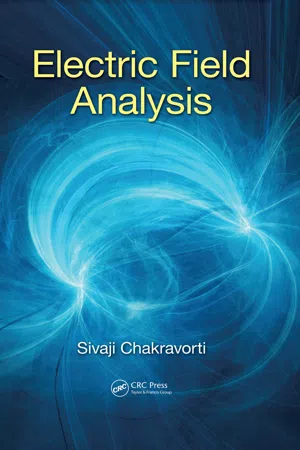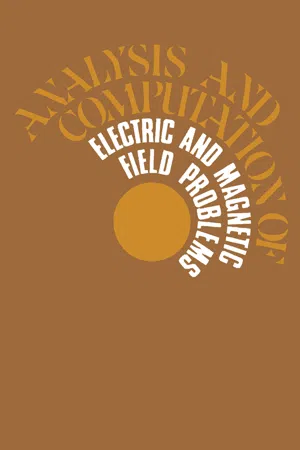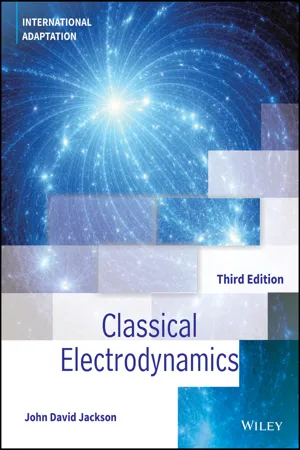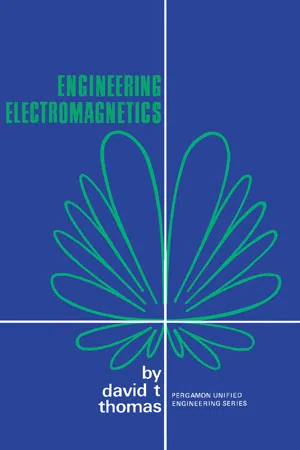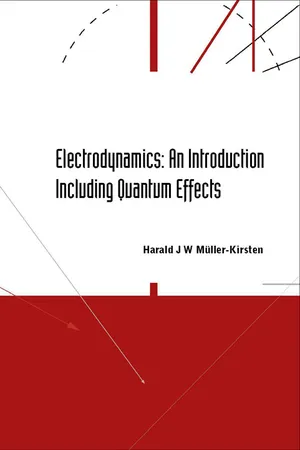Physics
Method of Images
The Method of Images is a technique used to solve problems involving electric charges and conductors. It involves creating a virtual charge or charges in strategic locations to satisfy boundary conditions. By using the principle of superposition, the total electric potential and field due to the actual and virtual charges can be determined, simplifying the problem-solving process.
Written by Perlego with AI-assistance
Related key terms
1 of 5
7 Key excerpts on "Method of Images"
- eBook - ePub
- Sivaji Chakravorti(Author)
- 2017(Publication Date)
- CRC Press(Publisher)
9Method of Images
ABSTRACT There are many electric field problems involving one or more types of charges in the presence of conducting surfaces with specific boundary conditions, which are difficult to satisfy, if the governing field equation such as Poisson’s or Laplace’s equations is to be solved directly. Very often these problems do not exhibit any symmetry. However, sometimes the placement of additional fictitious charges of appropriate magnitude at suitable locations does provide a solution to such problems depending on the geometry of the equipotential conducting surfaces. These fictitious charges are called image charges and the electric field distribution can then be determined in the region excluding that occupied by the image charges in a straightforward manner. Thus, without solving Poisson’s or Laplace’s equations, this method can give solutions to problems, which are otherwise difficult to obtain. This method of replacing the equipotential conducting surfaces by appropriate image charges in place of direct solution of Poisson’s or Laplace’s equations is called the Method of Images . It is possible to use this method when the boundary involves linear or curved surface.9.1 Introduction
To explain the idea behind the Method of Images, consider two distinctly different electrostatic problems. The real problem is the one in which a charge density is given in a finite domain V bounded by its surface S with specific boundary conditions on S . The other is a fictitious problem in which the charge density within the finite domain V is the same as that for the real problem, but the boundary surfaces are replaced by suitable fictitious charge distribution located outside the domain V . If the fictitious charge distribution is so chosen that the solution to the fictitious problem satisfies the boundary conditions specified in the real problem, then the solution to the fictitious problem is also the solution to the real problem. The fictitious charge distribution so determined is called the image of the true charge distribution - eBook - PDF
Analysis and Computation of Electric and Magnetic Field Problems
Pergamon International Library of Science, Technology, Engineering and Social Studies
- K. J. Binns, P. J. Lawrenson(Authors)
- 2013(Publication Date)
- Pergamon(Publisher)
PART II DIRECT METHODS This page intentionally left blank C H A P T E R 3 IMAGES 3.1. Introduction The Method of Images can be used to give solutions to some important problems involv-ing straight-line or circular boundaries and in a particularly simple manner; for it offers certain ready-made solutions which eliminate the need for formal solutions of Laplace's and Poisson's equations. The idea of images for field problems is due to Lord Kelvin, but Maxwell, Lodge, ( 1) and Searle ( 2) extended the scope of the method. The essence of the method consists in replacing the effects of a boundary on an applied field by simple distributions of currents or charges behind the boundary line (called images), the desired field being given by the sum of the applied and the image fields. A different system of images is required for the field on each side of a boundary, but a knowledge of one group of images quickly leads to the other, since the solutions for the two regions are connected by the boundary conditions. In the following discussion, the magnitudes and positions of images for the single straight-line and circular boundaries are established, for convenience, in terms of the electric field of a line charge using a method first indicated by Hammond ; ( 3) the distribution of surface charge (or polarity) representing the influence of the boundary is first found and is then replaced by a simple equivalent array (the images). (As shown in section 2.2.2, the electric field of a line charge and the magnetic field of a line current are analogous, and so, from a knowledge of the images of the electric one, the images of the magnetic one may be de-duced directly.) There is no general method of deriving the images for any given problem with multiple boundaries, though a method of successive approximation (see Maxwell, article 315), gives correct results in certain cases. - eBook - PDF
- John David Jackson(Author)
- 2021(Publication Date)
- Wiley(Publisher)
These charges are called image charges, and the replacement of the actual problem with boundaries by an enlarged region with image charges but not boundaries is called the Method of Images. The image charges must be external to the volume of interest, since their potentials must be solutions of the Laplace equation inside the volume; the “particular integral” (i.e., solution of the Poisson equation) is provided by the sum of the potentials of the charges inside the volume. A simple example is a point charge located in front of an infinite plane conductor at zero poten- tial, as shown in Fig. 2.1. It is clear that this is equivalent to the problem of the original charge and an equal and opposite charge located at the mirror-image point behind the plane defined by the position of the conductor. 2.2 | POINT CHARGE IN THE PRESENCE OF A GROUNDED CONDUCTING SPHERE As an illustration of the Method of Images we consider the problem illustrated in Fig. 2.2 of a point charge q located at y relative to the origin, around which is centered a grounded conducting sphere of radius a. We seek the potential Φ(x) such that Φ(|x| = a) = 0. By symmetry it is evident that the image charge q′ (assuming that only one image is needed) will lie on the ray from the origin to the charge q. If we consider the charge q outside the sphere, the image position y′ will lie inside the sphere. The potential due to the charges q and q′ is: Φ( ) x x y x y = - + - q q / / 4 4 0 0 π π ′ ′ (2.1) -q q q Figure 2.1 Solution by Method of Images. The original potential problem is on the left, the equivalent-image problem on the right. Chapter 2 Boundary-Value Problems in Electrostatics: I 54 We now must try to choose q′ and |y′| such that this potential vanishes at |x| = a. - eBook - PDF
Engineering Electromagnetics
Pergamon Unified Engineering Series
- David T. Thomas, Thomas F. Irvine, James P. Hartnett, William F. Hughes(Authors)
- 2013(Publication Date)
- Pergamon(Publisher)
All images are the simplest class of equivalence problems. In equivalence problems a hypothetical distribu-tion of charges or sources is proposed which results in solutions to our problems which are in every way correct —that is the solutions agree with all the necessary equations and conditions. 92 Techniques for the Electrostatic Field Returning to the mirror, we tend to think of the reflection as coming from the virtual image behind the mirror, whereas in truth the source of the reflection is electromagnetic currents excited on the surface of the mirror. But the equivalent, fictitious virtual image behind the mirror is much easier to understand and so is invariably used. This is always the reason for using equivalence principles — to produce simpler solutions. Image of a Point Charge in a Conducting Plane The fundamental problem of image theory is a point charge, Q, located above a large flat plate made of metal (which we always assume to be perfectly con-ducting). The geometry is shown in Fig. 3-21. A complete problem statement must include Laplace's Equation, which must hold for all points above the ground plane, except at the point charge. The rectangular coordinates will be used with the origin chosen directly below the point charge, Q, on the ground plane and with xyz axes as shown in Fig. 3-21. Fig. 3-21. Coordinates for image in a ground plane. Additional conditions are: 1. For points near the point charge, Q, the potential must become the potential of a point charge. That is, 2. For points approaching infinity, V -» 0. This is the condition at infinity, which has not yet received much attention. We could actually be more precise as to the nature of the potential at infinity, but for this problem it is unnecessary. Method of Images 93 3. On the ground plane (y = 0), the potential is zero (K=0). The actual condition is E tan = 0, but saying V = 0 is equivalent and simplifies this problem. - Harald J W M??ller-Kirsten(Author)
- 2004(Publication Date)
- WSPC(Publisher)
An analogous situation is obtained for the 52 CHAPTER 3. APPLICATIONS OF ELECTROSTATICS earthed conductor plates arranged as in Fig. 3.5. Although the method of image charges is used in applications, it is not always treated in relevant texts. Some texts which include it are those of Stiefel [15] and Zahn [8]. The method of image charges finds application for instance in the calculation of the electric field in particle detectors§ +1 Fig. 3.5 Conductors with angular orientation. Fig. 3.6 The oscillating charge. §See e.g. W. Weihs and G. Zech, Numerical Computation of Electrostatic Fields in Multiwire Chambers, Report Univ. Siegen, May 1989. 3.6 Theoretical Aspects of Image Charges 53 Example 3.4: The oscillating charge A pointlike mass m with charge q at the end of a string of length a oscillates in the gravitational field of the Earth above an earthed horizontal metal plate. The mass oscillates like a pendulum in a plane. Determine the equation of motion of the pendulum expressed in terms of the angular deflection 6’. What is the period in the case of small oscillations? Solution: Using the method of image charges as sketched in Fig. 3.6, we place a charge -q in the position of a mirror image of the charge +q, so that in the plane of the earthed conductor the potential 4 is zero. In this way we can ignore the plate (or its boundary condition) in the evaluation of the electric field. It is easiest to use the principle of conservation of energy E. The total energy of the charge +q is 1 q2 E = -m(a8l2 + mga(1- cOs e) - 2 ( 2 d + 2a - 2acosB)’ where d is the distance shown in Fig. 3.6. With it follows that q2a sine ( d + a - acosO)2 ma2$ + mga sin e + = 0. For 0 small we have I+ R28 N 0, Thus the desired period is T = 27r/R 3.6 Theoretical Aspects of Image Charges 3.6.1 The Induced Charge Before we investigate general theoretical aspects of the method, we consider an example: A charge q placed outside an earthed spherical shell of radius a.- eBook - PDF
- Reinaldo Perez(Author)
- 2013(Publication Date)
- Academic Press(Publisher)
Since each ele-mentary loop is equivalent to a magnetic dou-blet or to the element of a double layer, the loop as a whole is equivalent to a uniform double layer over S. 3.7. Method of Images Consider a system of isolated point charges in an infinite homogeneous medium. At an equipotential surface, imagine an infinitely thin, perfectly conducting sheet introduced over it. Since the component of E tangential to the surface is zero, the existing field is unaltered. The charges on one side of the sheet are said to be the images of the charges on the other side. For example, in the case of two equal and opposite charges (Figure 10), the plane per-pendicular to the bisector of the line joining the charges is an equipotential. The potential v =T-(--- ( 77 ) Aire r r' J determines the field of the two charges both before and after introduction of the conduct-ing sheet. Let us now remove the charge —q to infinity below the plane. The field above the plane remains unaffected and the field below goes to zero. Above the plane, the effect of the image charge is replaced by a distribution of charge on the plane. The density of this i I Figure 10 A point charge above a conducting plane and its image. -q<2) + i +q< 3 >+ 0)+ +q W+ -q Figure 11 A point charge in a quadrant formed by two conducting planes and its images. distribution is dV q d 11 1 D » = £E » = -e Tz = -^T z -r-7>Y (78) where the differentiation is performed at the plane. If h is the distance from the point charge to the plane, then qh Thus, the density of the charge induced on the plane by the point charge varies inversely as the cube of the distance from it. By integra-tion, the total induced charge is —q. Similarly, the potential of a point charge inside a quadrant formed by two perpendicu-lar conducting planes (Figure 11) is q [ 1 1 1 V=— + • (80) Aire r x r 2 r 3 r 4 ] In the case of two parallel planes, the number of images is infinite (Figure 12) in order to maintain each plane equipotential. - Luis Manuel Braga de Costa Campos(Author)
- 2014(Publication Date)
- CRC Press(Publisher)
605 Electric/Magnetic Multipoles and Images and hence also of the electric fields; in (8.198c and d), the sum over all even and odd n was split into two sums, one over even n = 2 m and the other over odd n = 2 m − 1 values. The Method of Images applies in two (three) dimensions to line (point) multipoles near: (1) a plane wall or corner [Chapter I.16; Sections I.24.4 and I.24.5, I.26.5 and I.26.6, I.36.1 and I.36.2 (Section 8.7 and Subsections 8.8.1 and 8.8.4)]; (2) between parallel walls or in rectangular wells [Sections I.36.6 through I.36.9 (Subsections 8.8.2 through 8.8.3 and 8.8.5)]; (3) a cylinder (Sections I.24.6 through I.24.8, I.26.7 and I.26.8, I.28.8 and I.29.9) [sphere (Section 8.9 next)]. 8.9 Discrete or Continuous Images in Spheres The Method of Images applies to a conducting (Subsection 8.9.1) sphere and specifies the force exerted upon it by a point charge due to the distribution of induced electric charges (Subsection 8.9.2). The electric charge distribution induced in the conducting sphere (Subsection 8.9.1) reduces the effect of the original electric charge in the far field (Subsection 8.9.2). The case of a point electric charge near an insulating sphere (Subsection 8.9.3) is analogous to the potential flow due to a source near a rigid impermeable sphere. The case of a rigid ≡ insulating sphere involves besides the image point source at the reciprocal point (Subsection 8.9.4) a continuous sink distribution (Subsection 8.9.5) to cancel the flow rate inside the sphere. This specifies the velocity field (Subsection 8.9.6) including on the sphere (Subsection 8.9.7). Continuous sink distributions (Subsection 8.9.8) may be used to represent the poten-tial flow past axisymmetric bodies of different shapes such as fairings (finite) bodies [Subsection 8.9.9 (Subsection 8.9.10)] with arbitrary shape (Subsection 8.9.11).
Index pages curate the most relevant extracts from our library of academic textbooks. They’ve been created using an in-house natural language model (NLM), each adding context and meaning to key research topics.
